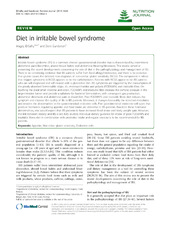Diet in irritable bowel syndrome
| dc.contributor.author | El-Salhy, Magdy | en_US |
| dc.contributor.author | Gundersen, Doris Irene | en_US |
| dc.date.accessioned | 2015-11-12T08:41:16Z | |
| dc.date.available | 2015-11-12T08:41:16Z | |
| dc.date.issued | 2015-04-14 | |
| dc.Published | Nutrition Journal 2015, 14:36 | eng |
| dc.identifier.issn | 1475-2891 | |
| dc.identifier.uri | https://hdl.handle.net/1956/10651 | |
| dc.description.abstract | Irritable bowel syndrome (IBS) is a common chronic gastrointestinal disorder that is characterized by intermittent abdominal pain/discomfort, altered bowel habits and abdominal bloating/distension. This review aimed at presenting the recent developments concerning the role of diet in the pathophysiology and management of IBS. There is no convincing evidence that IBS patients suffer from food allergy/intolerance, and there is no evidence that gluten causes the debated new diagnosis of non-coeliac gluten sensitivity (NCGS). The component in wheat that triggers symptoms in NCGS appears to be the carbohydrates. Patients with NCGS appear to be IBS patients who are self-diagnosed and self-treated with a gluten-free diet. IBS symptoms are triggered by the consumption of the poorly absorbed fermentable oligo-, di-, monosaccharides and polyols (FODMAPs) and insoluble fibre. On reaching the distal small intestine and colon, FODMAPS and insoluble fibre increase the osmotic pressure in the large-intestine lumen and provide a substrate for bacterial fermentation, with consequent gas production, abdominal distension and abdominal pain or discomfort. Poor FODMAPS and insoluble fibres diet reduces the symptom and improve the quality of life in IBS patients. Moreover, it changes favourably the intestinal microbiota and restores the abnormalities in the gastrointestinal endocrine cells. Five gastrointestinal endocrine cell types that produce hormones regulating appetite and food intake are abnormal in IBS patients. Based on these hormonal abnormalities, one would expect that IBS patients to have increased food intake and body weight gain. However, the link between obesity and IBS is not fully studied. Individual dietary guidance for intake of poor FODMAPs and insoluble fibres diet in combination with probiotics intake and regular exercise is to be recommended for IBS patients. | en_US |
| dc.language.iso | eng | eng |
| dc.publisher | BioMed Central Ltd | eng |
| dc.rights | This is an Open Access article distributed under the terms of the Creative Commons Attribution License (http://creativecommons.org/licenses/by/4.0), which permits unrestricted use, distribution, and reproduction in any medium, provided the original work is properly credited. The Creative Commons Public Domain Dedication waiver (http://creativecommons.org/publicdomain/zero/1.0/) applies to the data made available in this article, unless otherwise stated. | eng |
| dc.rights.uri | http://creativecommons.org/licenses/by/4.0/ | eng |
| dc.subject | Appetite | eng |
| dc.subject | Non-celiac gluten sensitivity | eng |
| dc.subject | Endocrine cells | eng |
| dc.title | Diet in irritable bowel syndrome | en_US |
| dc.type | Peer reviewed | |
| dc.type | Journal article | |
| dc.date.updated | 2015-11-06T12:07:25Z | |
| dc.description.version | publishedVersion | en_US |
| dc.rights.holder | Copyright El-Salhy and Gundersen; licensee BioMed Central. | |
| dc.identifier.doi | https://doi.org/10.1186/s12937-015-0022-3 | |
| dc.identifier.cristin | 1248494 | |
| dc.subject.nsi | VDP::Medisinske fag: 700::Klinisk medisinske fag: 750::Gasteroenterologi: 773 | |
| dc.subject.nsi | VDP::Midical sciences: 700::Clinical medical sciences: 750::Gastroenterology: 773 | |
| dc.subject.nsi | VDP::Medisinske fag: 700::Klinisk medisinske fag: 750::Radiologi og bildediagnostikk: 763 | |
| dc.subject.nsi | VDP::Midical sciences: 700::Clinical medical sciences: 750::Radiology and diagnostic imaging: 763 | |
| dc.subject.nsi | VDP::Medisinske Fag: 700::Klinisk medisinske fag: 750::Gasteroenterologi: 773 | en_US |
Tilhørende fil(er)
Denne innførselen finnes i følgende samling(er)
Med mindre annet er angitt, så er denne innførselen lisensiert som This is an Open Access article distributed under the terms of the Creative Commons Attribution License (http://creativecommons.org/licenses/by/4.0), which permits unrestricted use, distribution, and reproduction in any medium, provided the original work is properly credited. The Creative Commons Public Domain Dedication waiver (http://creativecommons.org/publicdomain/zero/1.0/) applies to the data made available in this article, unless otherwise stated.

